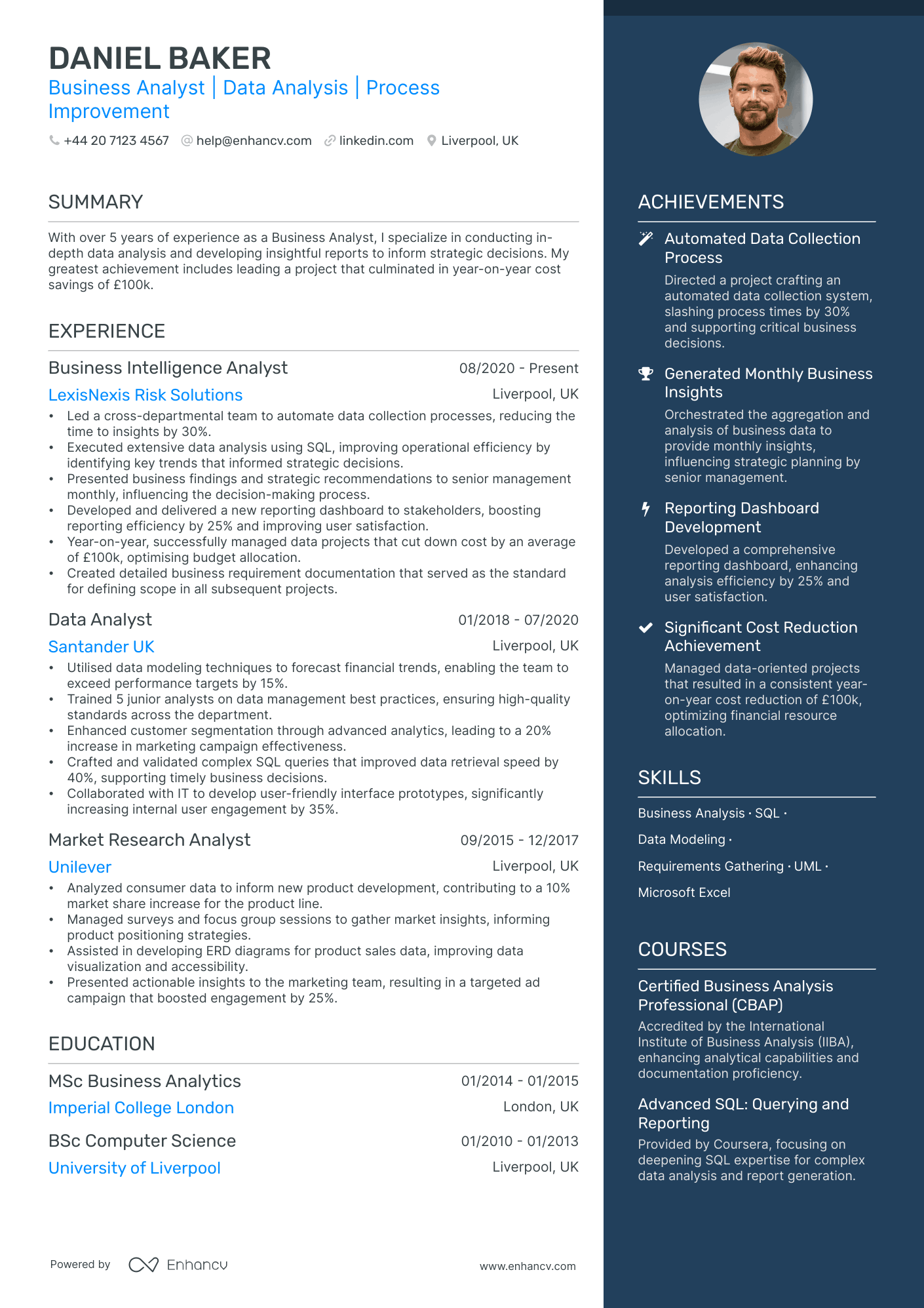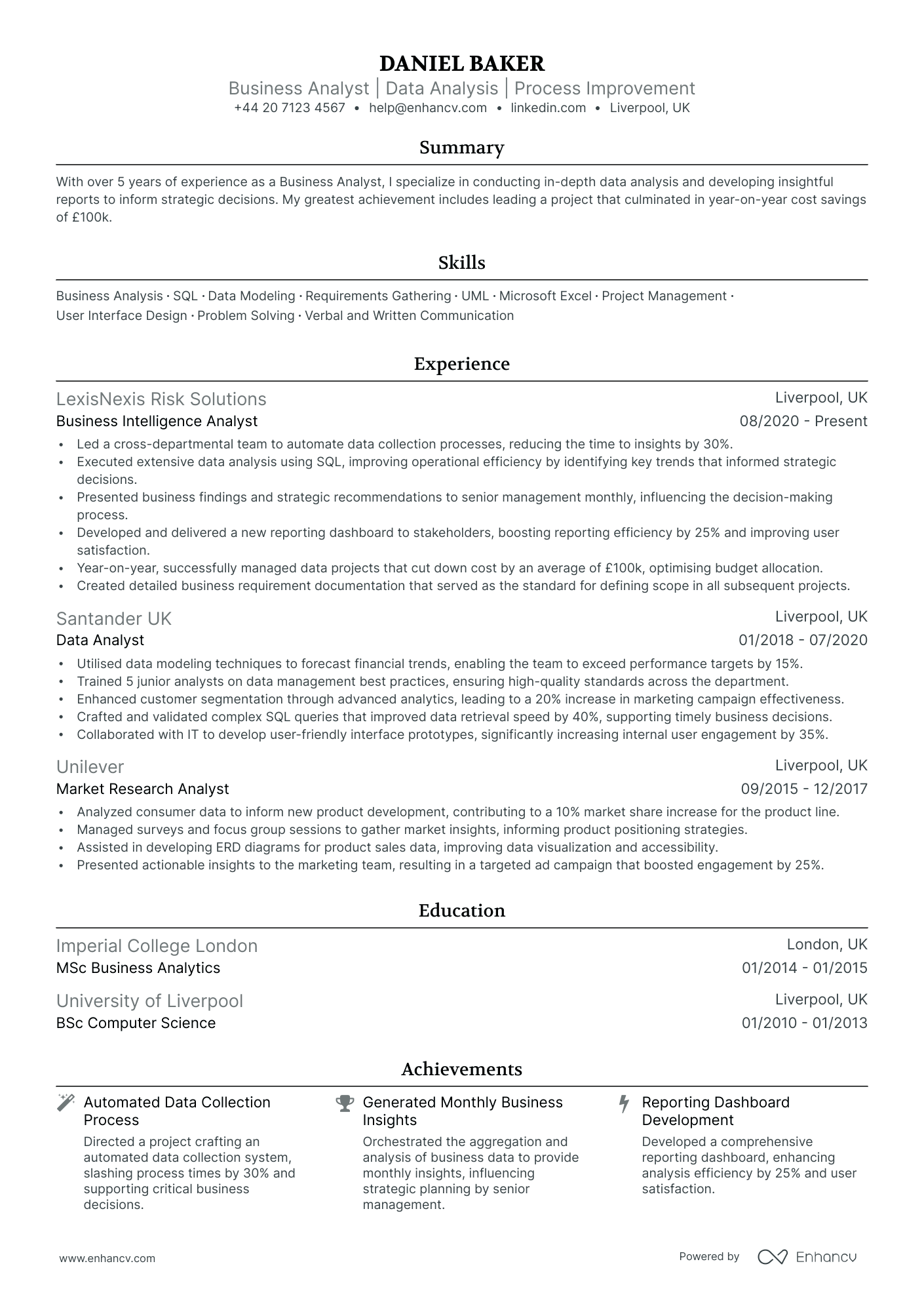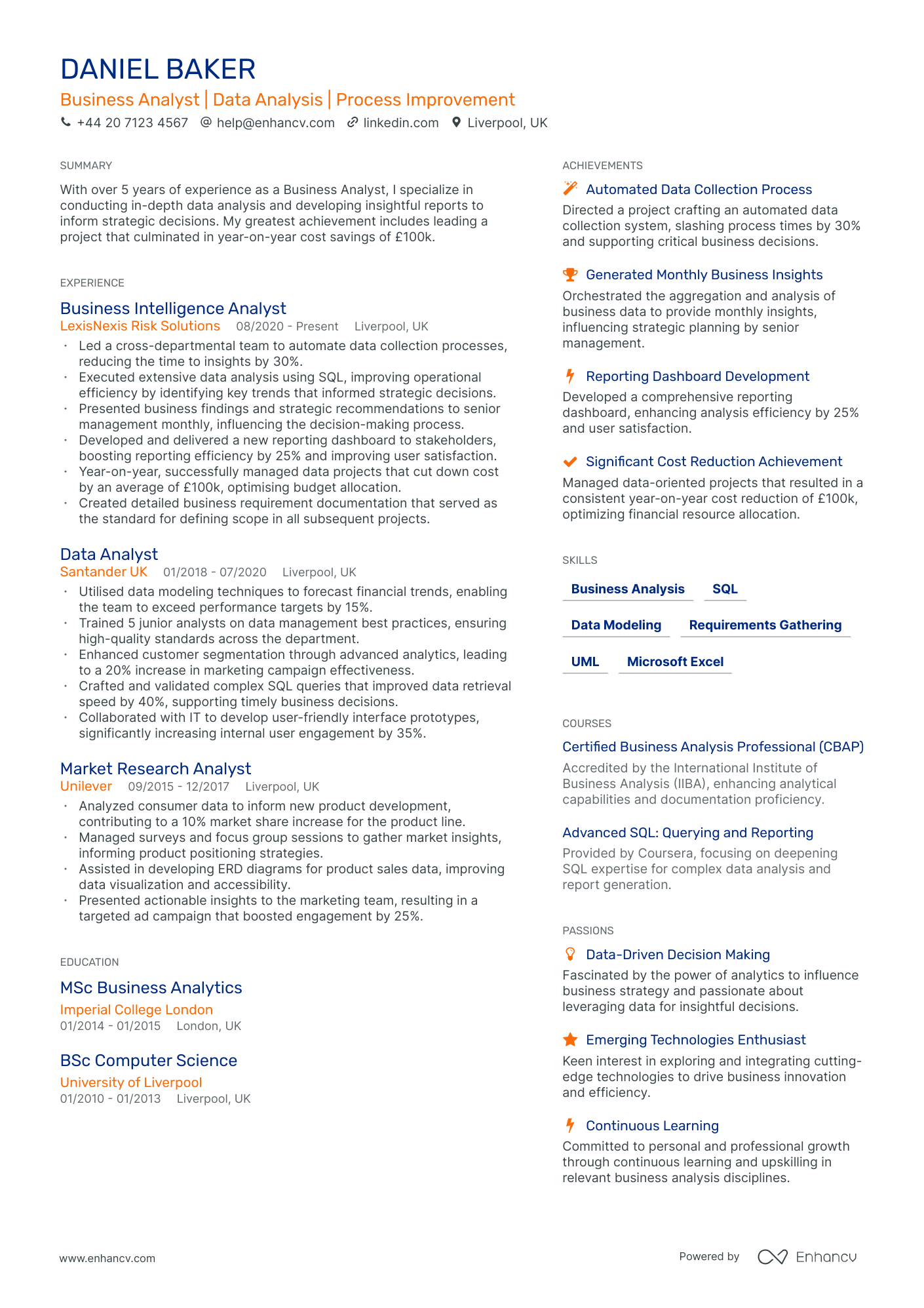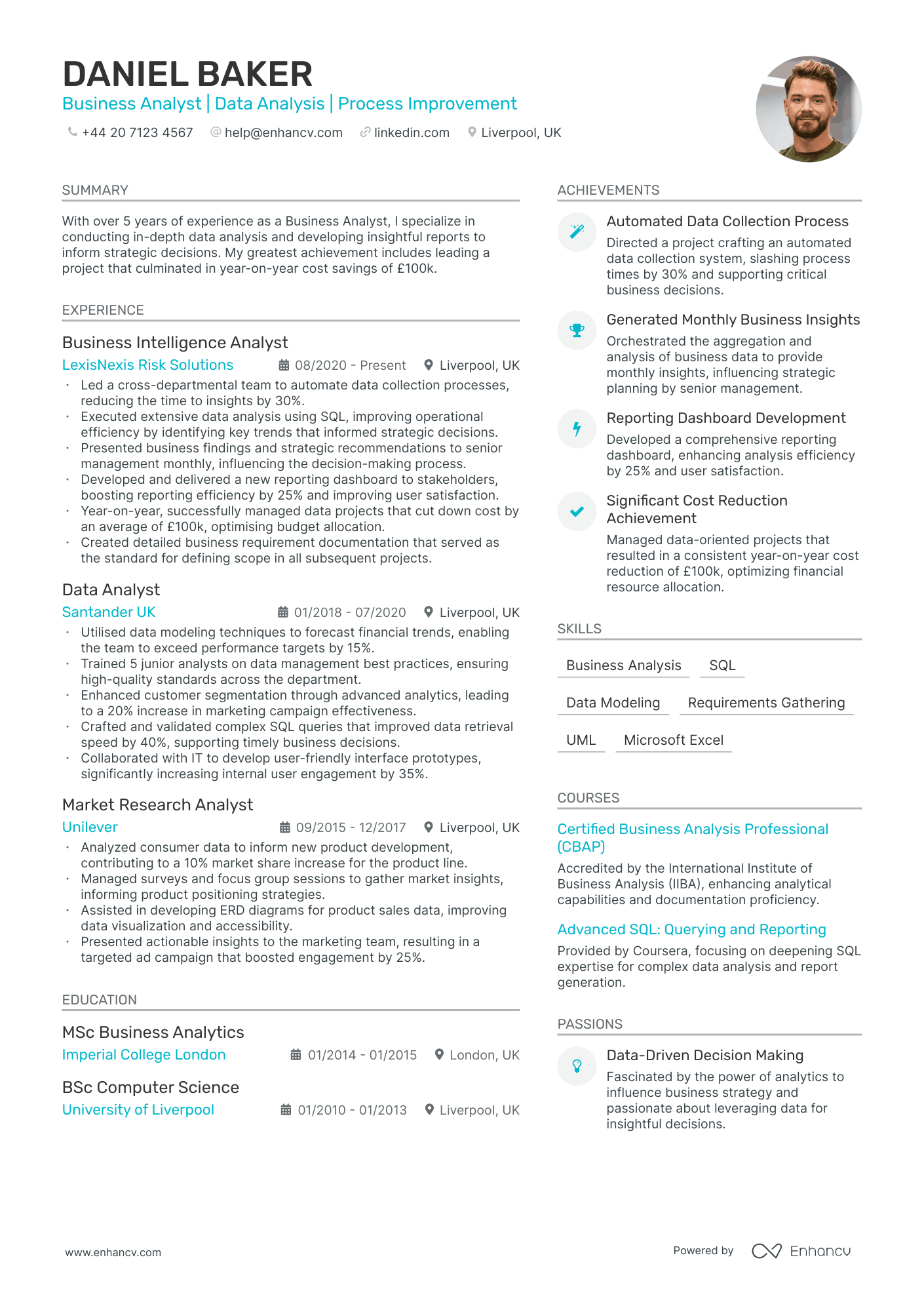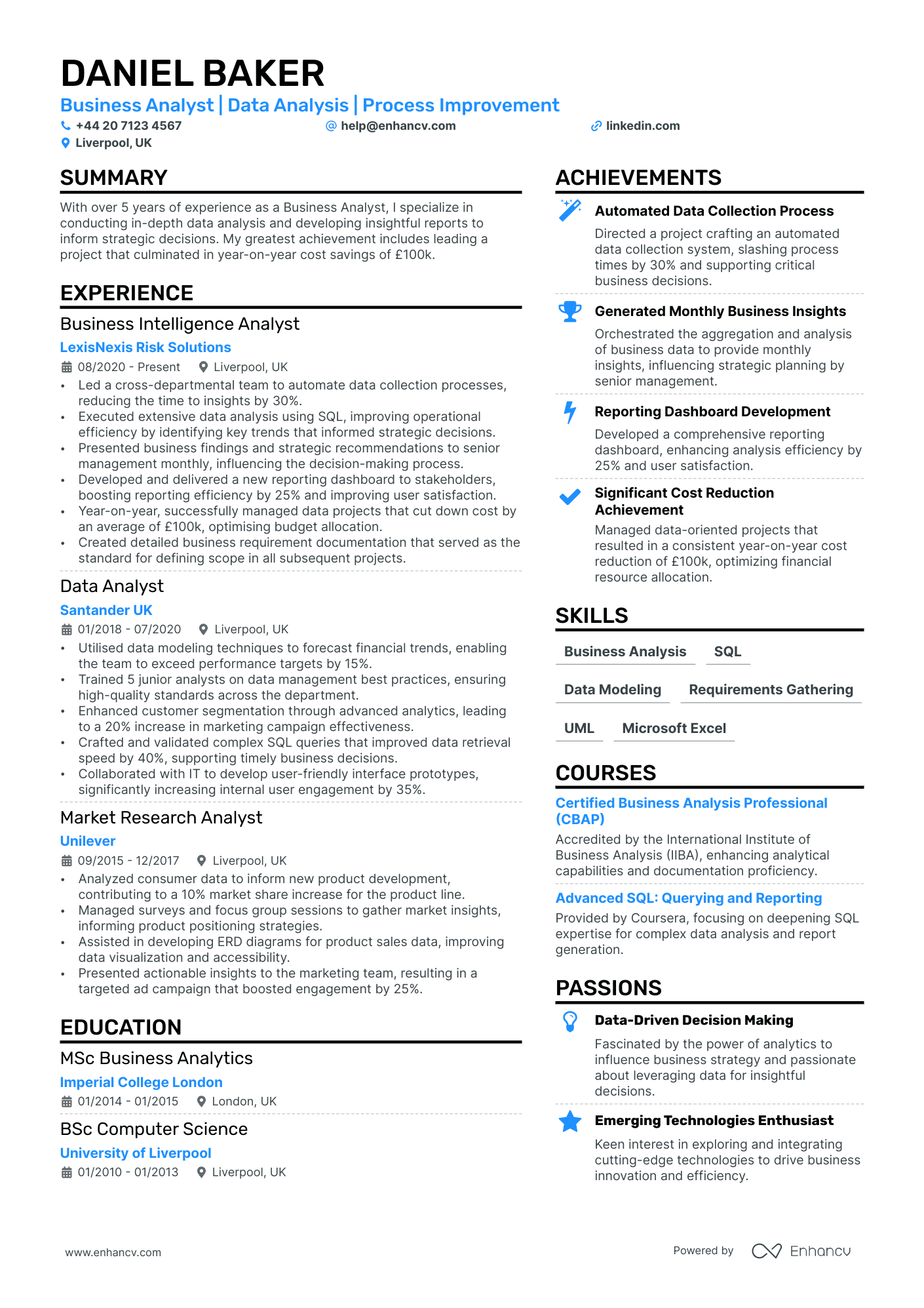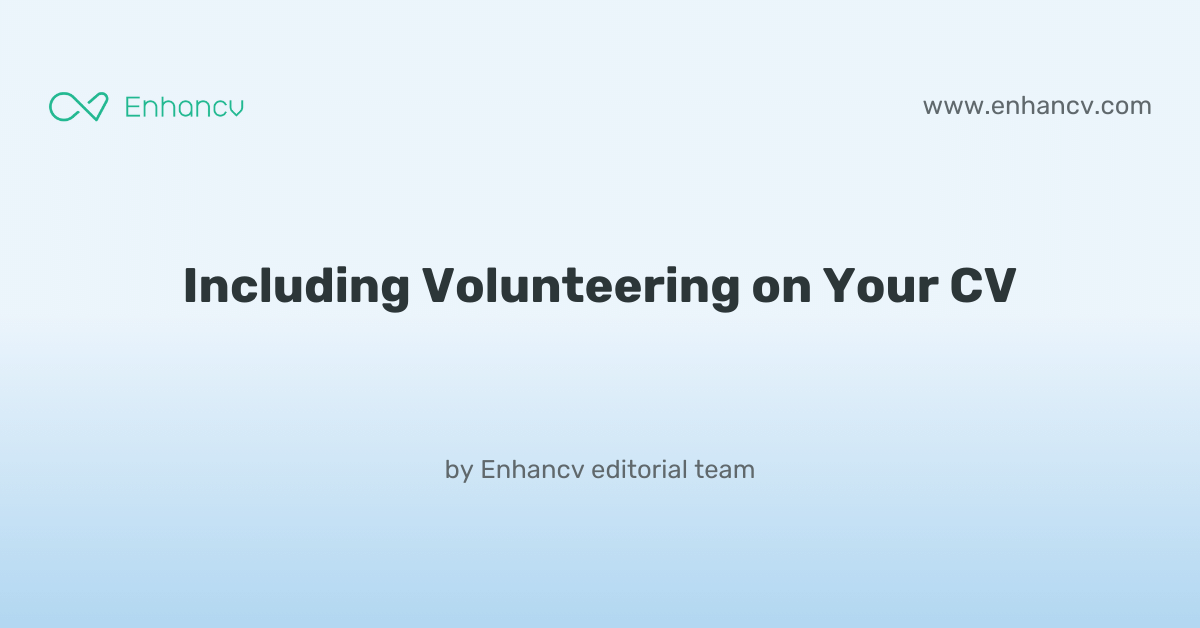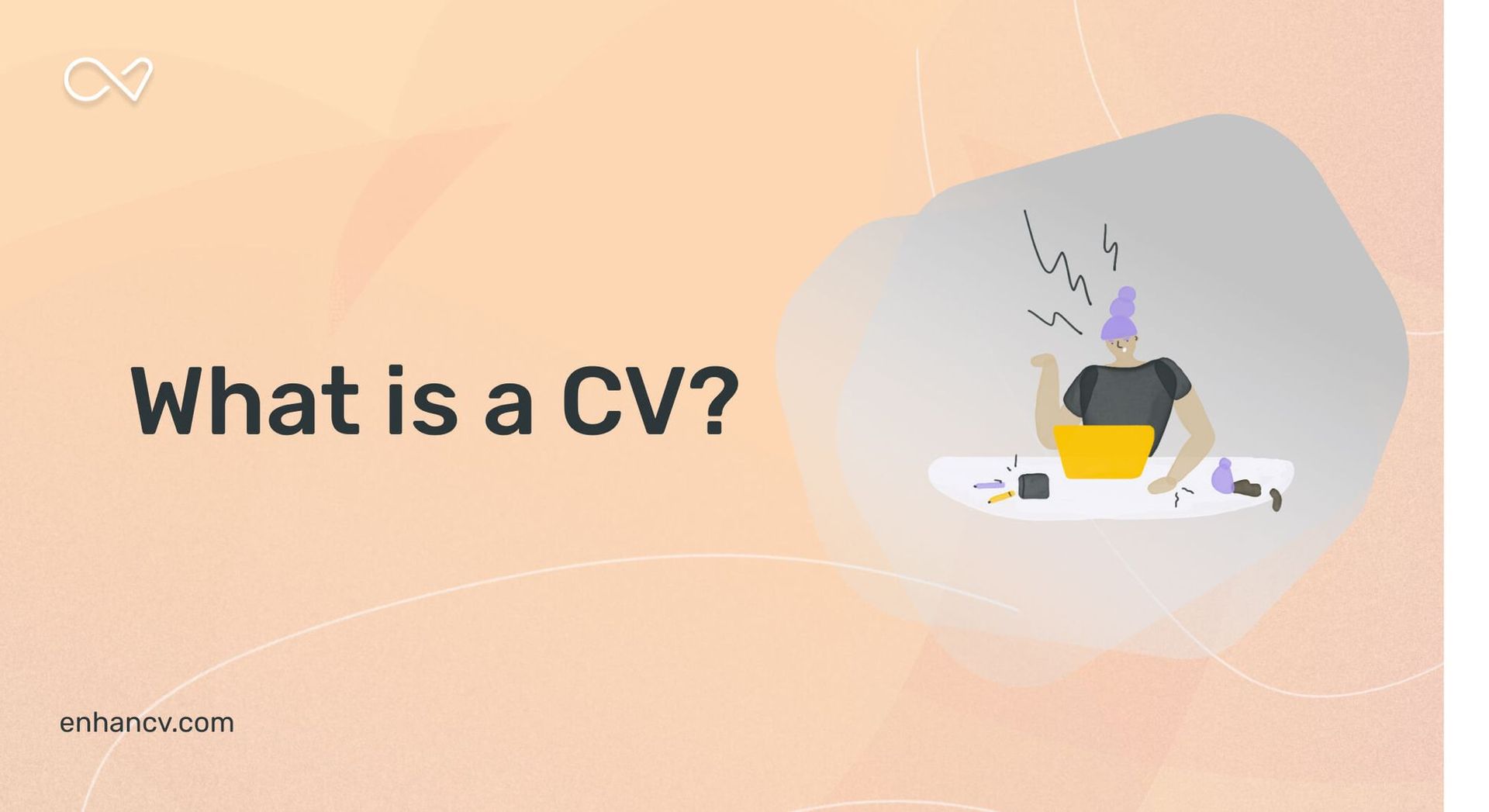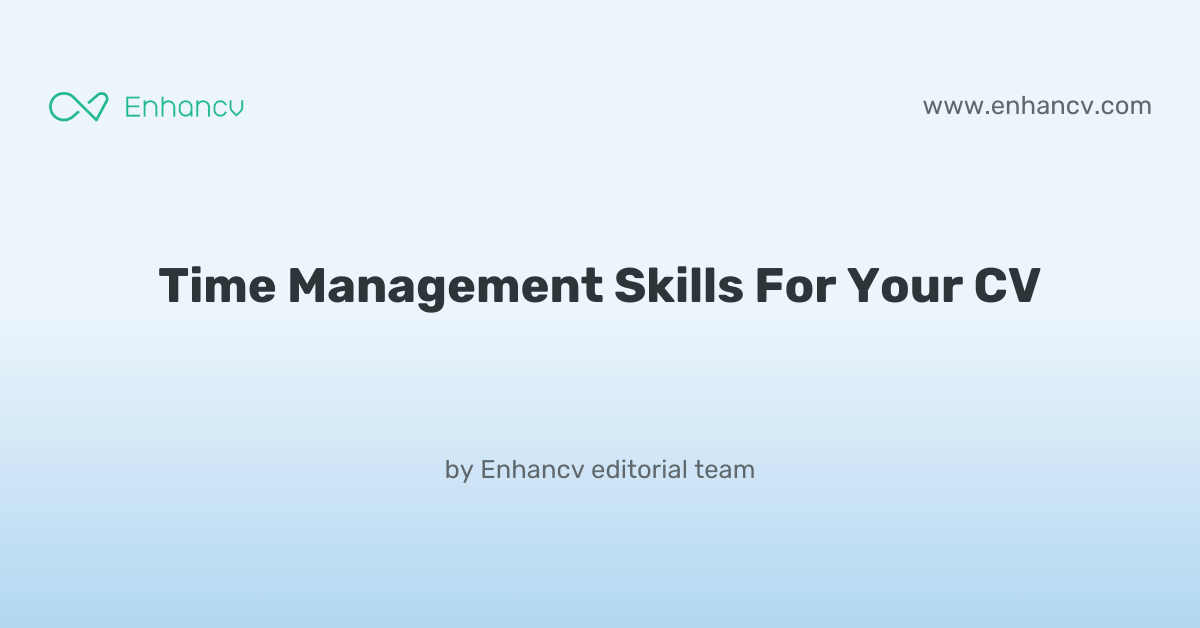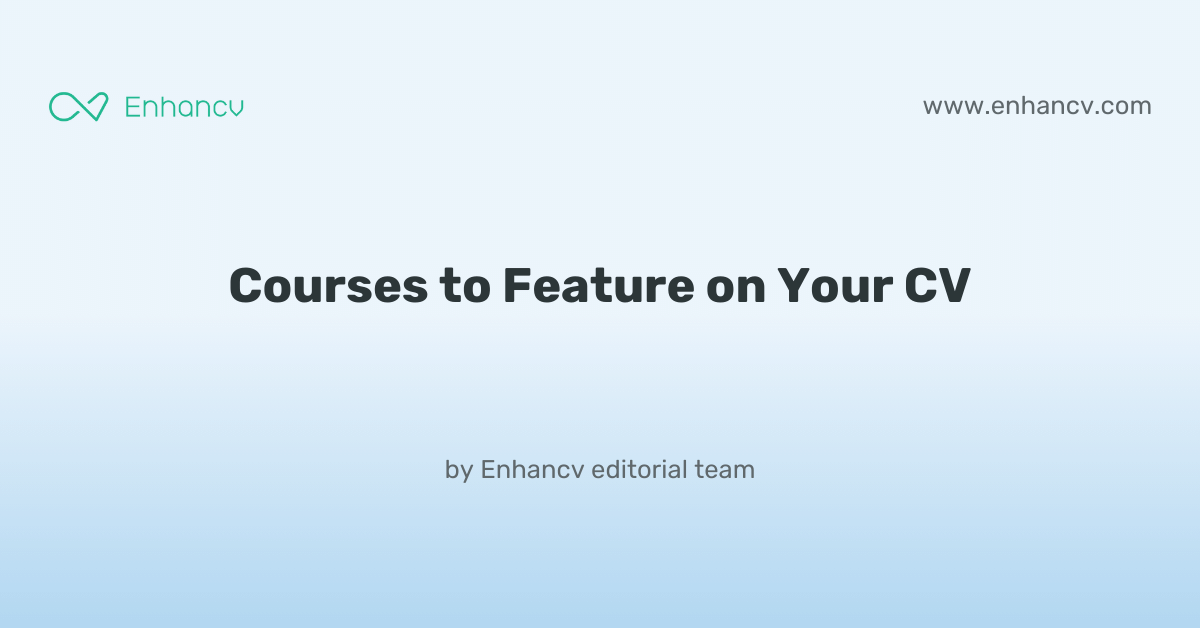Crafting your CV to stand out amidst the competition is a significant challenge for an entry-level business analyst. Our comprehensive guide provides tailored tips and strategies to help you highlight your analytical prowess and project experience effectively.
- Answer job requirements with your entry level business analyst CV and experience;
- Curate your academic background and certificates, following industry-leading CV examples;
- Select from +10 niche skills to match the ideal candidate profile
- Write a more succinct experience section that consists of all the right details.
Do you need more specific insights into writing your entry level business analyst CV? Our guides focus on unique insights for each individual role:
- Supervisor CV Example
- Business Manager CV Example
- Strategy Consultant CV Example
- Management Consultant CV Example
- Relationship Manager CV Example
- Business Development Executive CV Example
- Senior Business Analyst CV Example
- IT Business Analyst CV Example
- Business Intelligence CV Example
- Business Owner CV Example
Formatting your entry level business analyst CV to meet the role expectations
Staring at the blank page for hours on end, you still have no idea how you should start your professional entry level business analyst CV. Should you include more colours, two columns, and which sections? What you should remember about your CV format is this - ensure it's minimalistic and doesn't go over the top with fancy fonts and many colours. Instead, focus on writing consistent content that actually answers the job requirements. But, how about the design itself :- Use the reverse chronological order to showcase your experience, starting with your most recent role;
- Include your contact details (email address, phone number, and location) - and potentially your professional photo - in the header;
- Must-have CV sections include summary or objective, experience, education, and skills: curate the ones that fit your profile;
- Your professional entry level business analyst CV should be between one-to-two pages long: select the longer format if you have more experience.
A little bit more about your actual CV design, ensure you're using:
- plenty of serif or sans serif font (e.g. Montserrat, Exo 2, Volkhov) as they are Applicant Tracker System (ATS) compliant. Avoid the likes of Arial and Times New Roman because most candidates' CVs are in this typography.
When submitting your CV, are you still not sure what format it should be? Despite the myth that has been circling around, most modern ATS systems are perfectly capable of reading PDFs. This format is an excellent choice as it keeps all of your information intact.
PRO TIP
Be mindful of white space; too much can make the CV look sparse, too little can make it look cluttered. Strive for a balance that makes the document easy on the eyes.
The top sections on a entry level business analyst CV
- Personal Statement offers a concise introduction of your skills and career goals, tailored to the business analyst role, showcasing your potential to prospective employers.
- Key Skills and Technologies section highlights your proficiency in data analysis, relevant software, and business methodologies, crucial for a business analyst position.
- Educational Background demonstrates your foundational knowledge and relevant qualifications, especially if you hold a degree in business, finance, or IT.
- Relevant Work Experience details previous job roles or internships, focusing on analytical tasks and business process improvements.
- Projects and Case Studies provide examples of your analytical and problem-solving capabilities through real-world applications, underscoring your practical experience.
What recruiters value on your CV:
- Emphasise any analytical coursework or projects from your education that demonstrate your problem-solving and data analysis skills, as these are directly relevant to a business analyst role.
- Include experience with relevant software tools like Microsoft Excel, SQL, and business intelligence platforms, as they are essential for data manipulation and reporting tasks a business analyst frequently performs.
- Detail any internships or work experience where you have assisted in business strategy or decision-making processes, as this showcases your ability to contribute to core business analyst duties.
- Highlight your communication skills by mentioning presentations, reports, or group projects where you effectively conveyed complex information, as business analysts must interface between IT and business stakeholders.
- Be specific about your ability to work as part of a team, citing any collaborative projects or team-based extracurricular activities, since business analysts often work within cross-functional teams.
Recommended reads:
Tips and tricks on writing a job-winning entry level business analyst CV header
The CV header is the space which most recruiters would be referring most often to, in the beginning and end of your application. That is as the CV header includes your contact details, but also a headline and a professional photo. When writing your CV header:
- Double-check your contact details for spelling errors or if you've missed any digits. Also, ensure you've provided your personal details, and not your current work email or telephone number;
- Include your location in the form of the city and country you live in. If you want to be more detailed, you can list your full address to show proximity to your potential work place;
- Don't include your CV photo, if you're applying for roles in the UK or US, as this may bias initial recruiters' assessments;
- Write a professional headline that either integrates the job title, some relevant industry keywords, or your most noteworthy achievement.
In the next part of our guide, we'll provide you with professional CVs that showcase some of the best practices when it comes to writing your headline.
Examples of good CV headlines for entry level business analyst:
- Graduate Business Analyst | Data Interpretation & Visualisation | PRINCE2 Certified | Passion for Process Improvement
- Junior Business Analyst | Requirements Gathering Specialist | Agile Methodologies | SQL Proficient | 1 Year Experience
- Entry-Level Business Analyst | Financial Analytics Focus | Advanced Excel | Stakeholder Communication | Fresh Graduate
- Business Insights Analyst | Market Research & Trends | BSc Economics | Tableau Savvy | 2 Years' Insight
- Aspiring Business Analyst | Project Coordination | Client Relations | ITIL Foundation | Keen Problem Solver
- Emerging Business Analyst | CRM Analytics | Data-Driven Decision Making | CIMA Part-Qualified | 3 Years Commercial Acumen
Opting between a entry level business analyst CV summary or objective
Within the top one third of your entry level business analyst CV, you have the opportunity to briefly summarise your best achievements or present your professional goals and dreams. Those two functions are met by either the CV summary or the objective.
- The summary is three-to-five sentences long and should narrate your best successes, while answering key requirements for the role. Select up to three skills which you can feature in your summary. Always aim to present what the actual outcomes were of using your particular skill set. The summary is an excellent choice for more experienced professionals.
- The objective is more focused on showcasing your unique value as a candidate and defining your dreams and ambitions. Think about highlighting how this current opportunity would answer your career vision. Also, about how you could help your potential employers grow. The objective matches the needs of less experienced candidates, who need to prove their skill set and, in particular, their soft skills.
Still not sure about how to write your CV opening statement? Use some best industry examples as inspiration:
CV summaries for a entry level business analyst job:
- With 2 years of dedicated experience in financial analysis at a thriving London-based start-up, I have honed my skills in data interpretation, SQL, and Excel. My efforts contributed significantly to a 20% increase in cost-saving measures through meticulous trend analysis.
- As an adept marketing strategist transitioning into business analysis, I bring 3 years of experience in data-driven campaign management. Proficient in Tableau and Python, my analytical approach yielded a record 35% growth in audience engagement for a major Manchester-based agency.
- Coming from a robust engineering background, I am excited to leverage my 4 years of experience and strong analytical skills, including expertise in MATLAB and data modeling, to derive actionable insights in business analysis. Successfully optimized production processes, achieving a 15% reduction in costs.
- Eager to apply my comprehensive understanding of market dynamics and my proficiency in CRM tools and advanced Excel functions to a career in business analysis, having excelled in a 5-year tenure as a sales manager which saw an increase in sales revenue by an impressive 25%.
- Seeking to contribute fresh analytical perspectives with an earnest ability to learn and integrate financial theories and models. Zealous about turning raw data into meaningful insights, although lacking direct experience, my extensive coursework in analytics and internship in market research are gateways to tangible impacts.
- With a strong academic foundation in business intelligence, I aim to transition my theoretical knowledge into practical applications as a business analyst. Although new to the industry, my passion for data storytelling and proficiency in statistical software positions me to provide unique contributions to data-driven decision-making.
Best practices for writing your entry level business analyst CV experience section
If your profile matches the job requirements, the CV experience is the section which recruiters will spend the most time studying. Within your experience bullets, include not merely your career history, but, rather, your skills and outcomes from each individual role. Your best experience section should promote your profile by:
- including specific details and hard numbers as proof of your past success;
- listing your experience in the functional-based or hybrid format (by focusing on the skills), if you happen to have less professional, relevant expertise;
- showcasing your growth by organising your roles, starting with the latest and (hopefully) most senior one;
- staring off each experience bullet with a verb, following up with skills that match the job description, and the outcomes of your responsibility.
Add keywords from the job advert in your experience section, like the professional CV examples:
Best practices for your CV's work experience section
- Conducted thorough market research to understand industry trends and provide foundational data for strategic decision-making, presenting findings to senior analysts.
- Assisted in the development and implementation of data collection systems and other strategies that optimise statistical efficiency and data quality for business analysis.
- Collaborated with cross-functional teams, including IT and finance departments, to understand business processes and contribute to the development of solutions that improve efficiency.
- Utilised a variety of analytical techniques such as SWOT, PESTLE, and Porter's Five Forces to assess potential business scenarios and outcomes.
- Supported project management activities by helping to prepare project documentation, such as project plans, business cases, and risk assessments.
- Created detailed reports and presentations to illustrate complex data in a clear and understandable manner for stakeholders at various organisational levels.
- Engaged in user acceptance testing of new systems, ensuring that business requirements were adequately met and providing feedback for enhancements.
- Analyzed customer feedback and sales data to identify areas for business improvement and suggest actionable insights for increasing sales and customer satisfaction.
- Worked with senior business analysts to develop and refine business intelligence tools, dashboards, and reports that help the organisation measure key performance indicators.
- Conducted in-depth data analysis using statistical tools like Excel and Tableau to identify key market trends, which led to a 10% increase in targeted marketing campaign effectiveness.
- Collaborated with cross-functional teams to gather requirements for the development of a new CRM system, ensuring alignment with business objectives and timely project delivery.
- Translated complex datasets into understandable KPI reports for senior management, directly supporting decision-making processes and strategic planning sessions.
- Implemented process improvements in the supply chain workflows, achieving a 15% reduction in operational costs through the identification of inefficiency bottlenecks.
- Developed and managed comprehensive financial models to support the company's expansion strategy, providing insights that influenced the launch into two new markets.
- Designed and executed user acceptance tests for a revamped ordering system, which heightened system reliability by 25% and improved user satisfaction scores.
- Spearheaded a market research project that profiled customer segments and recommended product adjustments, leading to a bespoke product line that outperformed sales projections by 30%.
- Authored detailed business requirement documents that captured intricate workflow processes, facilitating the successful integration of a new inventory management system.
- Coordinated with IT teams to refine business intelligence dashboard features, ensuring the delivery of real-time data insights that optimized operational decision-making.
- Performed rigorous cost-benefit analysis for proposed IT investments, influencing the prioritization of projects and securing a 20% budget increase for high-impact initiatives.
- Facilitated stakeholder workshops that gathered actionable feedback on system requirements, directly shaping the development of a customer-facing portal.
- Assisted in the quarterly financial reporting process by extracting and interpreting data sets, enhancing report accuracy and providing valuable commentary on variances.
- Optimized sales forecasting models based on historical data and predictive analysis, which resulted in a 12% improvement in inventory turnover rate.
- Captured and translated end-user requirements into detailed technical specifications for a mobile application project, achieving a 40% increase in user engagement post-launch.
- Initiated a competitor analysis study to benchmark company performance, uncovering insights that shaped marketing strategies and boosted market share by 5%.
- Led the assessment of operational risk within core business processes, resulting in the development of a risk mitigation plan that reduced potential financial losses by 20%.
- Conducted scenario planning and analysis to support leadership in the decision-making process for long-term business investments, ensuring alignment with strategic goals.
- Managed the rollout of a new SAP ERP module to streamline inventory management, which cut down order processing timeframes by 35%.
- Collaborated with the marketing team to refine campaign strategies using A/B testing and data analytics, leading to an increment in conversion rates by 18%.
- Assisted in the migration of company data to a cloud-based storage solution, enhancing data accessibility and reliability for remote teams.
- Performed regular SWOT analysis to assess corporate positioning and strategic initiatives, providing a foundation for the quarterly review and planning cycle.
- Collaborated on the development of an analytics platform that tracked performance metrics, resulting in a user-friendly dashboard that saved the company over 60 hours in monthly reporting activities.
- Conducted regular reviews of internal processes, implementing automation that saved the team an average of 10 hours per week on repetitive tasks.
- Played a key role in the post-merger integration project, harmonizing data systems between the two companies, which standardized reporting mechanisms across the newly formed entity.
How to ensure your entry level business analyst CV stands out when you have no experience
This part of our step-by-step guide will help you substitute your experience section by helping you spotlight your skill set. First off, your ability to land your first job will depend on the time you take to assess precisely how you match the job requirements. Whether that's via your relevant education and courses, skill set, or any potential extracurricular activities. Next:
- Systematise your CV so that it spotlights your most relevant experience (whether that's your education or volunteer work) towards the top;
- Focus recruiters' attention to your transferrable skill set and in particular how your personality would be the perfect fit for the role;
- Consider how your current background has helped you build your technological understanding - whether you've created projects in your free time or as part of your uni degree;
- Ensure you've expanded on your teamwork capabilities with any relevant internships, part-time roles, or projects you've participated in the past.
Recommended reads:
PRO TIP
Talk about any positive changes you helped bring about in your previous jobs, like improving a process or helping increase efficiency.
Describing your unique skill set using both hard skills and soft skills
Your entry level business analyst CV provides you with the perfect opportunity to spotlight your talents, and at the same time - to pass any form of assessment. Focusing on your skill set across different CV sections is the way to go, as this would provide you with an opportunity to quantify your achievements and successes. There's one common, very simple mistake, which candidates tend to make at this stage. Short on time, they tend to hurry and mess up the spelling of some of the key technologies, skills, and keywords. Copy and paste the particular skill directly from the job requirement to your CV to pass the Applicant Tracker System (ATS) assessment. Now, your CV skills are divided into:
- Technical or hard skills, describing your comfort level with technologies (software and hardware). List your aptitude by curating your certifications, on the work success in the experience section, and technical projects. Use the dedicated skills section to provide recruiters with up to twelve technologies, that match the job requirements, and you're capable of using.
- People or soft skills provide you with an excellent background to communicate, work within a team, solve problems. Don't just copy-paste that you're a "leader" or excel at "analysis". Instead, provide tangible metrics that define your success inusing the particular skill within the strengths, achievements, summary/ objective sections.
Top skills for your entry level business analyst CV:
Data Analysis
Microsoft Excel
SQL
Business Intelligence Tools
Statistical Analysis
Data Visualization
Report Writing
Requirements Gathering
Process Mapping
Project Management Software
Analytical Thinking
Problem-Solving
Attention to Detail
Communication
Teamwork
Time Management
Critical Thinking
Adaptability
Active Learning
Work Ethic
PRO TIP
Use mini case studies or success stories in your CV to demonstrate how your skills have positively impacted previous roles or projects.
Listing your university education and certificates on your entry level business analyst CV
The best proof of your technical capabilities would be your education and certifications sections. Your education should list all of your relevant university degrees, followed up by their start and completion dates. Make sure to also include the name of the university/-ies you graduated from. If you happen to have less professional experience (or you deem it would be impressive and relevant to your application), spotlight in the education section:
- that you were awarded a "First" degree;
- industry-specific coursework and projects;
- extracurricular clubs, societies, and activities.
When selecting your certificates, first ask yourself how applicable they'd be to the role. Ater your initial assessment, write the certificate and institution name. Don't miss out on including the completion date. In the below panel, we've curated relevant examples of industry-leading certificates.
PRO TIP
If you have received professional endorsements or recommendations for certain skills, especially on platforms like LinkedIn, mention these to add credibility.
Recommended reads:
Key takeaways
What matters most in your entry level business analyst CV-writing process is for you to create a personalised application. One that matches the role and also showcases your unique qualities and talents.
- Use the format to supplement the actual content, to stand out, and to ensure your CV experience is easy to comprehend and follows a logic;
- Invest time in building a succinct CV top one third. One that includes a header (with your contact details and headline), a summary or an objective statement (select the one that best fits your experience), and - potentially - a dedicated skills section or achievements (to fit both hard skills and soft skills requirements);
- Prioritise your most relevant (and senior) experience closer to the top of your CV. Always ensure you're following the "power verb, skill, and achievement" format for your bullets;
- Integrate both your technical and communication background across different sections of your CV to meet the job requirements;
- List your relevant education and certificates to fill in gaps in your CV history and prove to recrutiers you have relevant technical know-how.
